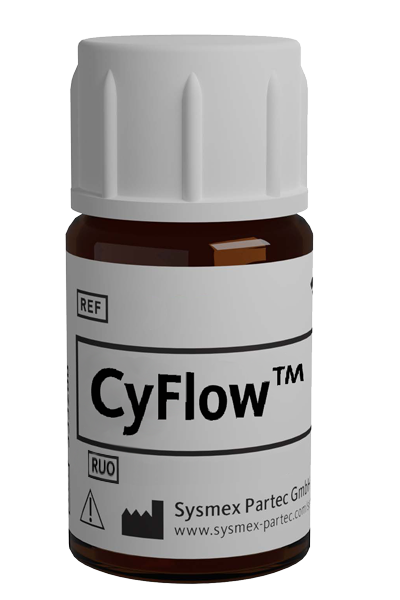CyFlow™ CD5 PerCP

| Alternative Name: | Leu-1, T1 |
| Antibody: | Yes |
| Antigen: | CD5 |
| Application: | Flow cytometry |
| Clonality: | monoclonal |
| Clone: | L17F12 |
| Emission Maximum: | 678 nm |
| Excitation Maximum: | 482 to 490 nm |
| Field of Interest: | Immunophenotyping |
| Format/Fluorochrome: | PerCP |
| Isotype: | IgG2a |
| Laser: | Blue , Green |
| Regulatory Status: | RUO |
| Source Species: | Mouse |
| Target Species: | Human |
| Product number: | BK331753 |
For Research Use Only
| HLDA Workshop | HLDA II |
| Quantity | 100 tests |
| Volume | 1.0 mL |
| Immunogen | Human Acute Lymphocytic Leukemia (ALL) T cells |
| Background Information | CD5 (T1) is a human cell surface T-lymphocyte single-chain transmembrane glycoprotein. CD5 is expressed on all mature T-lymphocytes, most of thymocytes, subset of B-lymphocytes and on many T-cell leukemias and lymphomas. It is a type I membrane glycoprotein whose extracellular region contains three scavenger receptor cysteine-rich (SRCR) domains. The CD5 is a signal transducing molecule whose cytoplasmic tail is devoid of any intrinsic catalytic activity. CD5 modulates signaling through the antigen-specific receptor complex (TCR and BCR). CD5 crosslinking induces extracellular Ca++ mobilization, tyrosine phosphorylation of intracellular proteins and DAG production. Preliminary evidence shows protein associations with ZAP-70, p56lck, p59fyn, PC-PLC, etc. CD5 may serve as a dual receptor, giving either stimulatory or inhibitory signals depending both on the cell type and development stage. In thymocytes and B1a cells seems to provide inhibitory signals, in peripheral mature T lymhocytes it acts as a costimulatory signal receptor. CD5 is the phenotypic marker of a B cell subpopulation involved in the production of autoreactive antibodies. Disease relevance: CD5 is a phenotypic marker for some B cell lymphoproliferative disorders (B-CLL, Hairy cell leukemia, etc.). The CD5+ popuation is expanded in some autoimmune disorders (Rheumatoid Arthritis, etc.). Herpes virus infections induce loss of CD5 expression in the expanded CD8+ human T cells. |
| Usage | The reagent is designed for Flow Cytometry analysis of human blood cells. Recommended usage is 10·µl reagent·/ 100·µl of whole blood or 10^6 cells in a suspension. The content of a vial (1 ml) is sufficient for 100 tests. |
| Storage Buffer | The reagent is provided in stabilizing phosphate buffered saline (PBS) solution, pH ≈7.4, containing 0.09% (w/v) sodium azide. |
| Storage | Avoid prolonged exposure to light. Store in the dark at 2-8°C. Do not freeze. |
| Stability | Do not use after expiration date stamped on vial label. |
| Engleman EG, Warnke R, Fox RI, Dilley J, Benike CJ, Levy R: Studies of a human T lymphocyte antigen recognized by a monoclonal antibody. Proc Natl Acad Sci USA. 1981 Mar; 78(3):1791‑5. < PMID: 7015346 > | Shuster JJ, Falletta JM, Pullen DJ, Crist WM, Humphrey GB, Dowell BL, Wharam MD, Borowitz M: Prognostic factors in childhood T‑cell acute lymphoblastic leukemia: a Pediatric Oncology Group study. Blood. 1990 Jan 1; 75(1):166‑73. < PMID: 1688495 > | McAlister MS, Davis B, Pfuhl M, Driscoll PC: NMR analysis of the N‑terminal SRCR domain of human CD5: engineering of a glycoprotein for superior characteristics in NMR experiments. Protein Eng. 1998 Oct; 11(10):847‑53. < PMID: 9862202 > | Gong JZ, Lagoo AS, Peters D, Horvatinovich J, Benz P, Buckley PJ: Value of CD23 determination by flow cytometry in differentiating mantle cell lymphoma from chronic lymphocytic leukemia/small lymphocytic lymphoma. Am J Clin Pathol. 2001 Dec; 116(6):893‑7. < PMID: 11764079 > | Dunphy CH, Tang W: The value of CD64 expression in distinguishing acute myeloid leukemia with monocytic differentiation from other subtypes of acute myeloid leukemia: a flow cytometric analysis of 64 cases. Arch Pathol Lab Med. 2007 May; 131(5):748‑54. < PMID: 17488160 >
